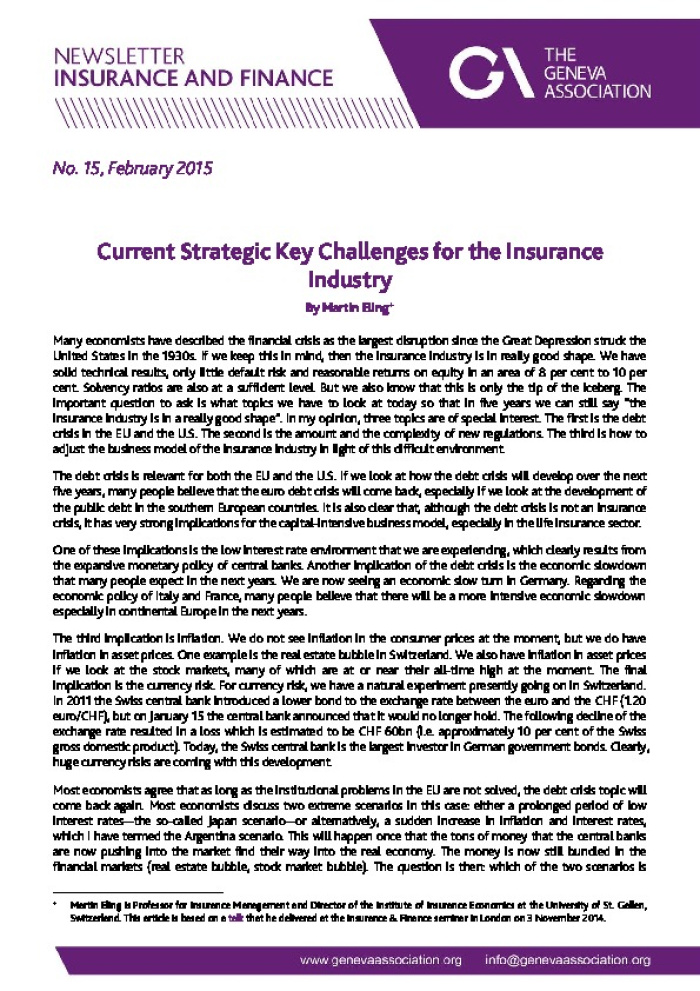Current Strategic Key Challenges for the Insurance Industry
Article from Insurance and Finance Newsletter No.15. M. Eling outlines his academic perspective on the strategic challenges facing the insurance industry, not least the ongoing debt crisis and the wave of new regulation, asking what this means for insurers.

No. 15 , February 2015 Current Strategic Key Cha llenges for the Insurance Industry By Martin Eling+ Many economists have described the financial crisis as the largest disruption since the Great Depression struck the United States in the 1930s. If we keep this in mind, then the insurance industry is in really good shape. We have solid technical results, only little default risk and reasonable returns on equity in an area of 8 per cent to 10 per cent. Solvency ratios are also at a sufficient level. But we also know that this is only the tip of the iceberg. The important question to ask is what topics we have to look at today so that in five years we can still say ?the insurance industry is in a really good shape?. In my opinion, three topics are of special interest. The first is the debt crisis in the EU and the U.S. The second is the amount and the complexity of new regulations. The third is how to adjust the business model of the insuranc e industry in light of this difficult environment. The debt crisis is relevant for both the EU and the U.S. If we look at how the debt crisis will develop over the next five years, many people believe that the euro debt crisis will come back, especially if we look at the development of the public debt in the southern European countries. It is also clear that, although the debt crisis is not an insurance crisis, it has very strong implications for the capital -intensive business model, especially in the life insurance sector. One of these implications is the low interest rate environment that we are experiencing, which clearly results from the expansive monetary policy of central banks. Another implication of the debt crisis is the economic slowdown that many people expect in the next years. We are now seeing an economic slow turn in Germany. Regarding the economic policy of Italy and France, many people believe that there will be a more intensive economic slowdown especially in continental Europe in the next y ears. The third implication is inflation. We do not see inflation in the consumer prices at the moment, but we do have inflation in asset prices. One example is the real estate bubble in Switzerland. We also have inflation in asset prices if we look at th e stock markets, many of which are at or near their all- time high at the moment. The final implication is the currency risk. For currency risk, we have a natural experiment presently going on in Switzerland. In 2011 the Swiss central bank introduced a lowe r bond to the exchange rate between the euro and the CHF (1.20 euro/CHF), but on January 15 the central bank announced that it would no longer hold. The following decline of the exchange rate resulted in a loss which is estimated to be CHF 60bn (i.e. appro ximately 10 per cent of the Swiss gross domestic product). Today, the Swiss central bank is the largest investor in German government bonds. Clearly, huge currency risks are coming with this development. Most economists agree that as long as the instituti onal problems in the EU are not solved, the debt crisis topic will come back again. Most economists discuss two extreme scenarios in this case: either a prolonged period of low interest rates ?the so- called Japan scenario ?or alternatively, a sudden increase in inflation and interest rates, which I have termed the Argentina scenario. This will happen once that the tons of money that the central banks are now pushing into the market find their way into the real economy. The money is now still bundled in the financial markets (real estate bubble, stock market bubble). The question is then: which of the two scenarios is + Martin Eling is Professor for Insurance Management and Director of the Institute of Insurance Economics at the University of St. Gallen, Switzerland. This article is based on a talk that he delivered at the Insurance & Finance seminar in London on 3 November 2014.